CarEdge saved me over 4,500 dollars on a brand new Honda Pilot. I can't say thank you enough.
Price intelligence
Find a wide range of vehicle listings with market insights on new and used listings near you.


Help us personalize your CarEdge experience — it only takes a second.
Your answers help us personalize your CarEdge journey — we’ll follow up with tips and next steps that match your buying timeline.

It’s true that SUVs have taken over the car market in recent years, but not all are hot sellers. In fact, the gap between the fastest and slowest-selling models is growing. In 2025, some SUVs and crossovers are being scooped up as soon as they hit the lot, while others are sitting unsold for more than six months. Whether you’re a buyer looking for a great deal or a seller trying to time the market, understanding which SUVs are moving (or not) is essential.
We analyzed August car market data to find the SUVs with the lowest and highest market day supply (MDS). MDS is a measure of how many days it would take to sell through current inventory at the current sales pace. Here are the winners and losers in 2025’s SUV market.
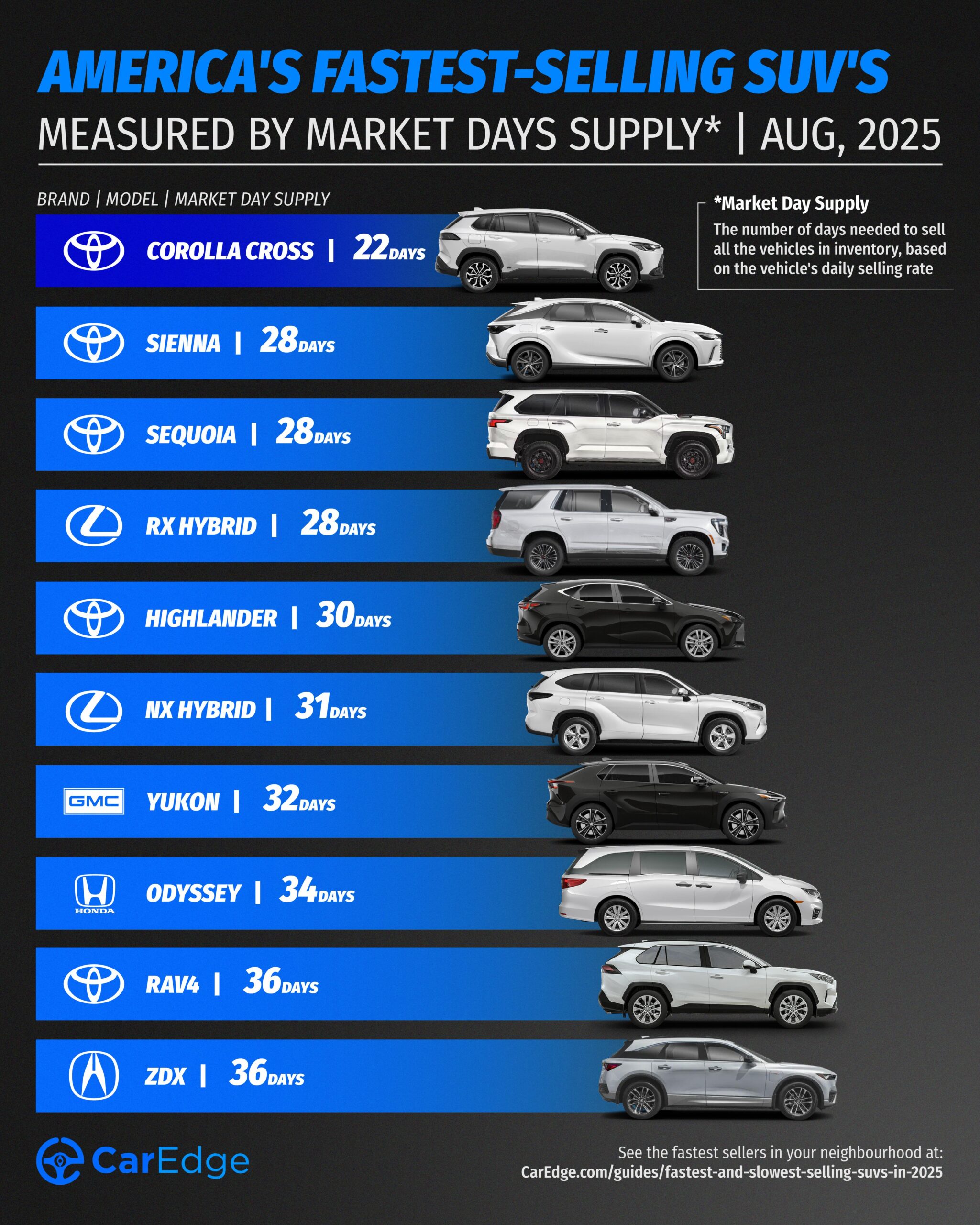
These are the SUVs and crossovers with the lowest market day supply as of August 2025. That means they’re in high demand right now, and are likely harder to negotiate on due to limited availability.
| Make | Model | Market Day Supply | Total For Sale | Total Sold (45 days) | Average Selling Price |
|---|---|---|---|---|---|
| Toyota | Corolla Cross | 22 | 9,443 | 18,965 | $31,181 |
| Toyota | Sienna | 28 | 9,572 | 15,344 | $51,591 |
| Toyota | Sequoia | 28 | 3,348 | 5,325 | $83,490 |
| Lexus | RX Hybrid | 28 | 2,511 | 4,085 | $63,083 |
| Toyota | Highlander | 30 | 5,470 | 8,172 | $52,052 |
| Lexus | NX Hybrid | 31 | 2,750 | 3,962 | $54,654 |
| GMC | Yukon | 32 | 4,373 | 6,126 | $87,674 |
| Honda | Odyssey | 34 | 5,654 | 7,574 | $46,334 |
| Toyota | RAV4 | 36 | 56,325 | 69,950 | $37,540 |
| Acura | ZDX | 36 | 1,217 | 1,501 | $68,906 |
Source: CarEdge Pro
Toyota’s reputation for reliability, fuel efficiency, and value continues to drive strong demand for Toyota SUVs like the Corolla Cross, Sienna, and Sequoia. Seven of the 10 fastest-selling SUVs in 2025 are Toyota or Lexus models. Lexus joins the mix with the RX and NX Hybrids, two compact options that luxury buyers love. GMC’s Yukon is the only ‘Detroit Big Three’ SUV on the list this month.
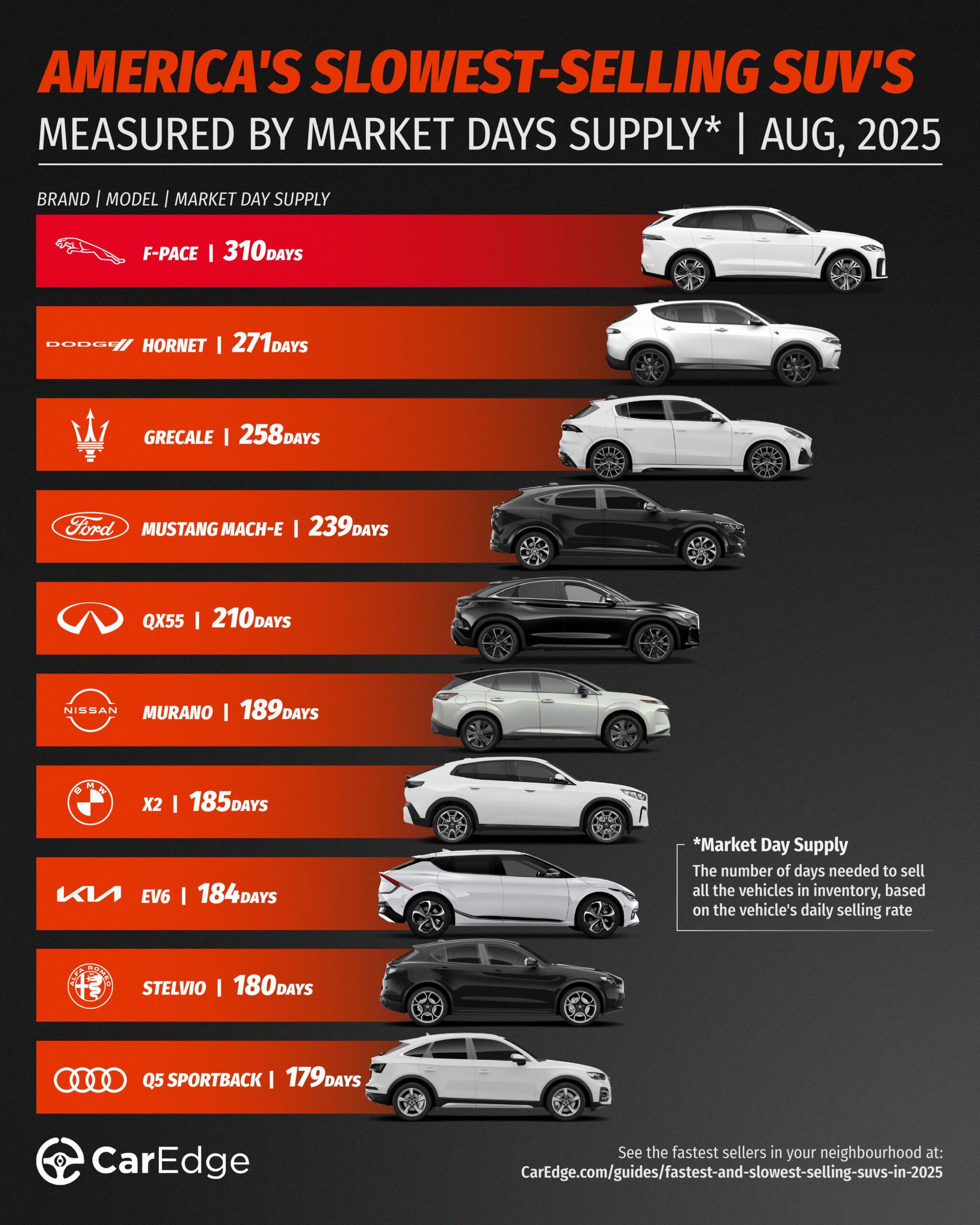
These SUVs have the highest market day supply, which means they’re sitting unsold for longer. Buyers may be able to score better deals on these slowest-selling SUVs in August, especially with this new AI negotiator doing the work for you.
| Make | Model | Market Day Supply | Total For Sale | Total Sold (45 days) | Average Selling Price |
|---|---|---|---|---|---|
| Jaguar | F-PACE | 310 | 2,751 | 399 | $69,742 |
| Dodge | Hornet | 271 | 2,911 | 484 | $36,536 |
| Maserati | Grecale | 258 | 631 | 110 | $79,872 |
| Ford | Mustang Mach-E | 239 | 22,597 | 4,247 | $48,656 |
| Infiniti | QX55 | 210 | 936 | 201 | $53,990 |
| Nissan | Murano | 189 | 20,164 | 4,797 | $47,020 |
| BMW | X2 | 185 | 1,238 | 301 | $52,596 |
| Kia | EV6 | 184 | 4,613 | 1,128 | $50,536 |
| Alfa Romeo | Stelvio | 180 | 842 | 210 | $56,239 |
| Audi | Q5 | 179 | 7,566 | 1,898 | $56,305 |
Source: CarEdge Pro
Many of these models fall into EV or luxury segments where buyer demand is softer in 2025. Jaguar’s F-PACE is the slowest-selling SUV today. Surprisingly, just three Stellantis models are in the bottom 10. The Ford Mustang Mach-E stands out as an electric SUV with sluggish sales despite aggressive incentives. There’s a lot more competition in the electric crossover segment, and Ford is struggling to keep up with hot sellers from GM, Hyundai, and Tesla.
For any of these slow-selling SUVs, prices will be more flexible if you come equipped with negotiation know-how.
If you’re looking for a deal, start with the slowest sellers this month. High inventory levels mean dealers are likely motivated to talk pricing if you negotiate with confidence. It’s always best to take a look at the best incentives of the month, too.
“If you’re shopping for a slow-selling SUV, the ball is in your court,” says auto industry veteran Ray Shefska. “Dealers know those vehicles aren’t moving, and that gives you the upper hand in price negotiations.”
Shopping Toyota, Honda, or Lexus? Expect tighter inventory and less room for negotiation. You may need to move quickly if you find the right trim. However, this is no reason to pay for unwanted add-ons or dealer markups!
Thinking about EVs? There are some good deals out there, but know what you’re getting into. EVs like the Mustang Mach-E might feature great incentives, but they also depreciate quickly. Unless you know you’ll be keeping your EV for several years, leasing is the smarter choice.
With CarEdge Concierge, our experts do the legwork for you, from researching inventory to negotiating with dealers. Already know what you want? Use our AI Negotiation Expert service and have CarEdge AI negotiate with car dealers anonymously!
Explore more free tools and resources with car buying guides, cost of ownership comparisons, and downloadable cheat sheets. There’s no reason to shop unprepared in 2025!
CarEdge is a trusted resource for car buyers, offering data-backed insights, negotiation tools, and expert guidance to help consumers save time and money. Since 2019, CarEdge has helped hundreds of thousands of drivers navigate the car-buying process with confidence. Learn how to buy a car the easy way at CarEdge.com.

Not all trucks fly off the lot. In fact, the gap between the fastest and slowest-selling pickups is wider than ever in 2025. With some trucks selling in just over a month, and others sitting unsold for over six months, knowing what’s hot (and what’s not) can make or break your next deal.
That’s why understanding Market Day Supply (MDS) is more important than ever for anyone buying or selling a truck in 2025. At CarEdge, we used real-time inventory and sales data to identify the fastest- and slowest-selling trucks in August 2025.
MDS tells us how long it would take to sell all the current inventory of a particular model at the current sales pace, assuming no new units are added. A low MDS means a truck is selling quickly. A high MDS, on the other hand, signals oversupply, and that can mean buyers have more leverage at the dealership.
Whether you’re buying new or considering a trade-in, here’s what the latest market data from CarEdge Pro reveals about the best-selling and worst-selling trucks in America.
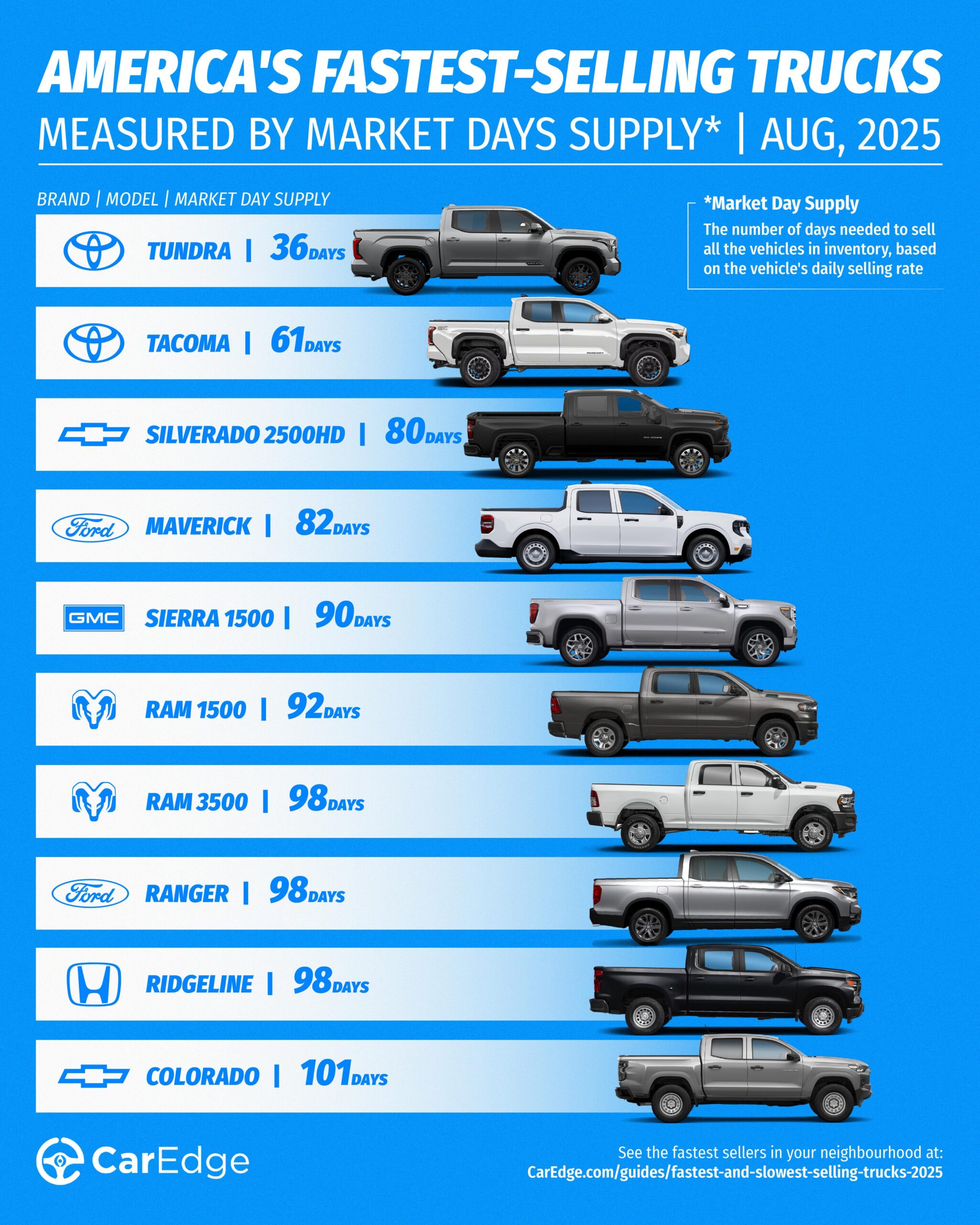
These trucks are in high demand and selling quickly. But if you’re hoping to negotiate a deal on one of these, don’t count on much wiggle room unless you work with a pro.
| Make | Model | Market Day Supply | Total For Sale | Total Sold (45-days) | Average Selling Price |
|---|---|---|---|---|---|
| Toyota | Tundra | 36 | 22,749 | 28,471 | $62,618 |
| Toyota | Tacoma | 61 | 65,840 | 48,478 | $46,065 |
| Chevrolet | Silverado 2500HD | 80 | 25,290 | 14,257 | $65,316 |
| Ford | Maverick | 82 | 26,332 | 14,392 | $32,780 |
| GMC | Sierra 1500 | 90 | 46,018 | 23,053 | $61,040 |
| Ram | Ram 1500 | 92 | 37,951 | 18,505 | $58,746 |
| Ram | Ram 3500 | 98 | 9,059 | 4,170 | $53,961 |
| Ford | Ranger | 98 | 14,265 | 6,543 | $43,902 |
| Honda | Ridgeline | 98 | 10,542 | 4,830 | $44,941 |
| Chevrolet | Colorado | 101 | 24,931 | 11,062 | $42,768 |
Source: CarEdge Pro
The Toyota Tundra is the fastest-selling pickup truck in August 2025. On average, the Tundra sits on the lot for just one month before finding a buyer. Toyota’s Tacoma is in second place, with trucks from GM, Ford, and Ram far behind.
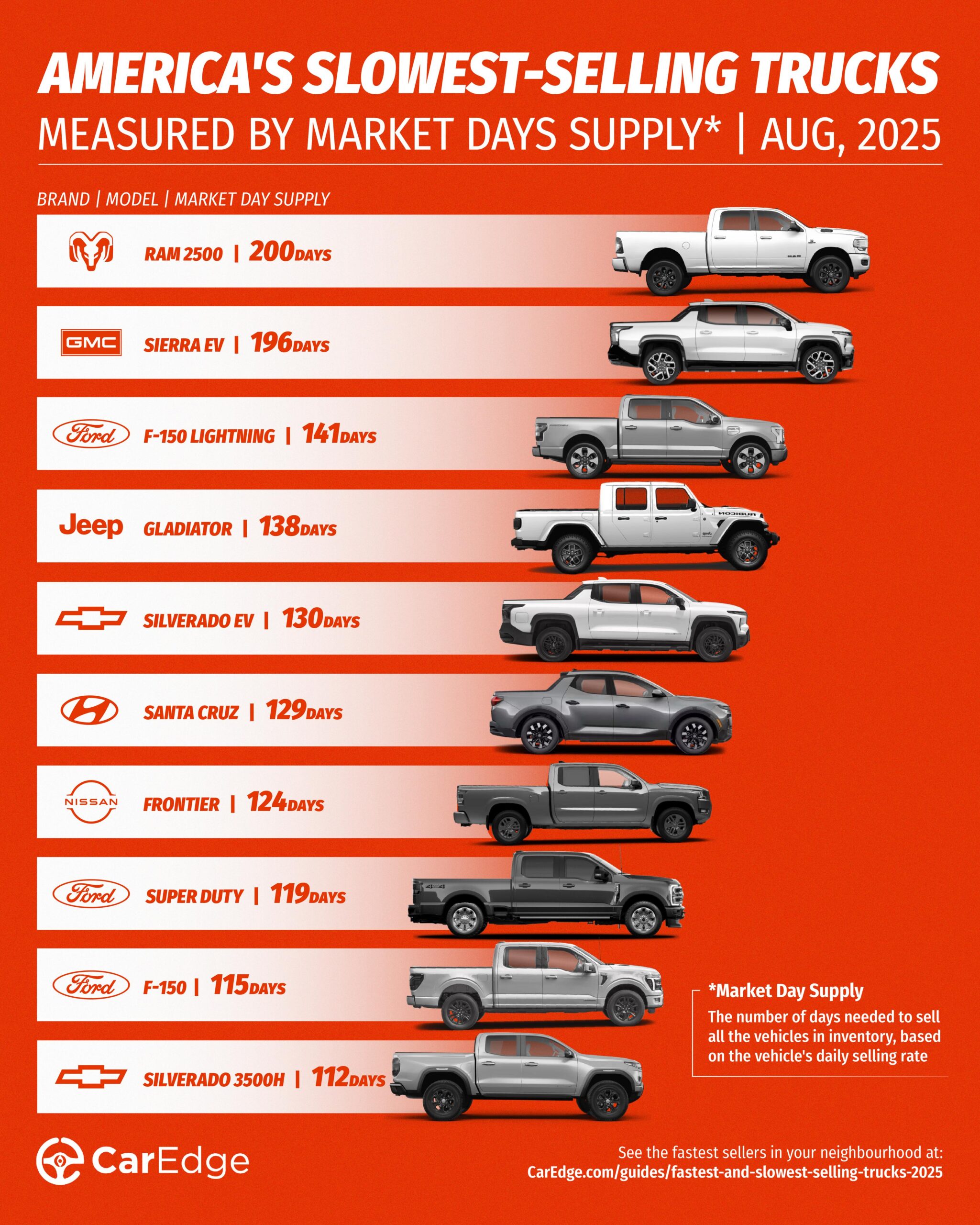
On the flip side, these trucks are struggling to move. Some of these trucks are taking more than six months to sell on average. If you’re in the market, these pickup trucks offer room for negotiation, especially with DIY market insights.
| Make | Model | Market Day Supply | Total For Sale | Total Sold (45 days) | Average Selling Price |
|---|---|---|---|---|---|
| Ram | Ram 2500 | 200 | 31,729 | 7,149 | $63,370 |
| GMC | Sierra EV | 196 | 3,707 | 853 | $92,215 |
| Ford | F-150 Lightning | 141 | 9,096 | 2,900 | $68,721 |
| Jeep | Gladiator | 138 | 17,419 | 5,672 | $47,500 |
| Chevrolet | Silverado EV | 130 | 3,661 | 1,263 | $92,215 |
| Hyundai | Santa Cruz | 129 | 9,279 | 3,231 | $35,724 |
| Nissan | Frontier | 124 | 18,228 | 6,629 | $39,132 |
| Ford | SuperDuty | 119 | 39,493 | 14,944 | $71,782 |
| Ford | F-150 | 115 | 116,720 | 45,571 | $59,354 |
| Chevrolet | Silverado 3500HD | 112 | 9,917 | 3,990 | $69,644 |
Source: CarEdge Pro
The Ram 2500 is the slowest-selling truck in America right now. However, electric pickup trucks are in second and third place as buyers struggle to make the switch to EVs. Sellers can expect these slow-selling trucks to sit on the lot for at least four months, but this creates great chances to negotiate savings for buyers.
As the truck market ebbs and flows, it’s easy to become overwhelmed. Luckily, there are new tools and services available that take the hassle out of buying a truck entirely. Here’s how CarEdge can help.
👉 Negotiate anonymously with CarEdge AI (NEW!)
👉 Have a pro negotiate your deal with CarEdge’s Car Buying Service

Buying a car doesn’t have to mean spending weekends at dealerships or stressing over sales tactics. If you’re looking for a hassle-free, professional way to purchase your next vehicle, car buying services, also known as car concierges, might be exactly what you need.
These services take care of the entire car buying process for you, from sourcing vehicles to negotiating prices and coordinating delivery. In this guide, we’ll explain exactly how car buying services work, what they offer, and why so many drivers choose to use one.
A car buying service, also known as a car concierge, is a professional service that simplifies the car buying process by doing the work for you. Whether you’re buying new or used, a concierge can help you find your ideal vehicle, negotiate the best price, and manage the paperwork and delivery.
Think of it as a personal assistant for buying a car — one that knows the auto industry inside and out and advocates for your best deal.
“If your car buying service seems too complicated, they’re doing something wrong. The best in the business are easy to understand and navigate.”
— CarEdge Team

Car buying services provide an all-in-one solution for shoppers who want to save time, money, and stress. Here’s what a top-tier car buying concierge will offer:
A concierge begins by learning your exact preferences — make, model, trim, color, features, budget, and timeline.
This is where the concierge adds serious value.
Already own a vehicle? No problem.
Once the deal is done, the concierge arranges delivery and ensures everything’s finalized.
Curious how it all comes together? Here’s what the car concierge process typically looks like:
Your journey begins with a quick consultation — by phone, email, or chat. You’ll share your goals, budget, preferences, and trade-in situation. Most services charge a flat fee between $1,000 and $3,000, sometimes with additional delivery charges.
The concierge searches the market and presents you with a handpicked list of vehicles that match your criteria.
Once you pick your top choice, the concierge gets to work negotiating.
With the deal locked in, your concierge arranges delivery or pickup, manages the paperwork, and ensures a smooth, painless handoff.

Wondering if a car buying service is worth it? Here are some of the top reasons drivers turn to a concierge:
Skip the dealership entirely. You don’t have to browse endless listings, haggle with salespeople, or worry about paperwork. Your concierge handles everything.
Concierges negotiate every day and know what’s fair — and what’s not. Many customers end up saving more than the cost of the service.
Buying a car can be overwhelming. A concierge makes it easy, clear, and confidence-inspiring. No pressure, no games.
Car concierges are perfect for:
When it comes to car buying services, not all concierges are created equal. CarEdge Concierge stands out with industry expertise, real-time market tools, and a track record of saving customers thousands.
With CarEdge, you’re not just hiring a service — you’re gaining a trusted advocate in your corner. Try CarEdge Concierge and make your next car purchase the easiest one yet.
Q: What is a car buying concierge?
A: A car buying concierge is a professional who helps you purchase a vehicle by handling the search, negotiation, trade-in, paperwork, and delivery — all on your behalf.
Q: How much does a car buying service cost?
A: Most services range from $1,000 to $3,000, plus delivery fees if the vehicle is shipped.
Q: Can a concierge help with used cars too?
A: Absolutely. Many customers use car buying services to find and negotiate for high-quality used vehicles.
Q: Do I still get to choose the car?
A: Yes! The concierge provides a shortlist of options, and you approve every step of the process.
Q: Is using a car buying service worth it?
A: If you value convenience, transparency, and expert-level negotiation, the answer is yes — especially when you consider the time and money you could save.
CarEdge is a trusted resource for car buyers, offering data-backed insights, negotiation tools, and expert guidance to help consumers save time and money. Since 2019, CarEdge has helped hundreds of thousands of drivers navigate the car-buying process with confidence. Learn more at CarEdge.com.
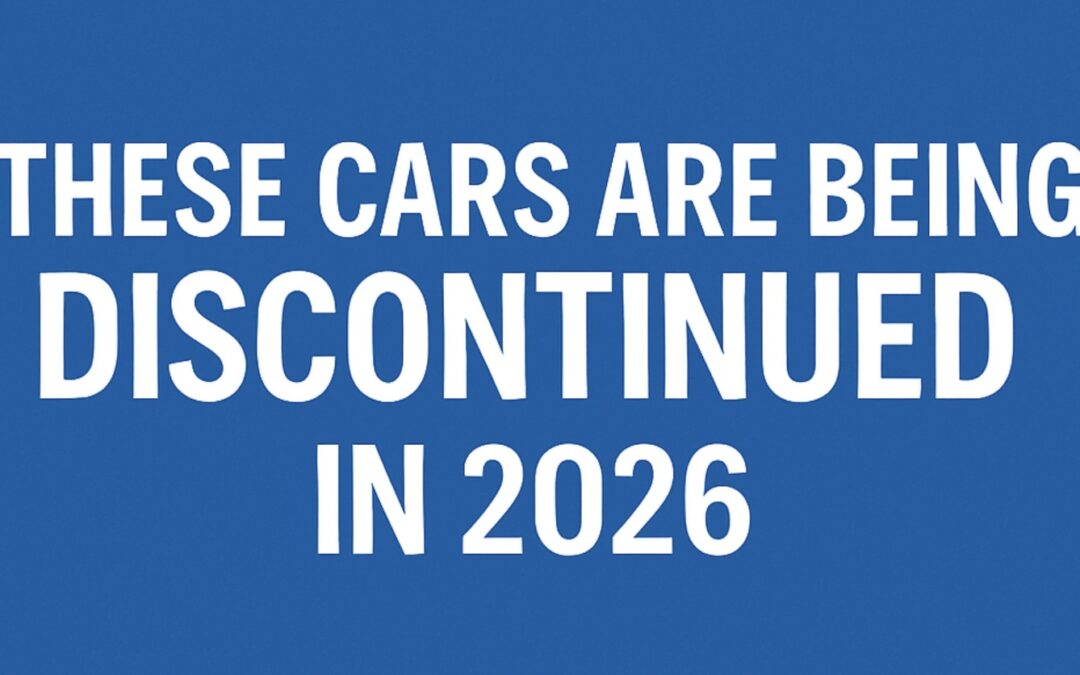
Another year, another batch of cars driving off into the sunset. As automakers shift toward electrification and trim unprofitable models, 2026 will bring a surprising number of cancellations. Longtime favorites like the Nissan Altima, Ford Escape, and Cadillac XT5 will be gone in 2026, despite continuing to sell in decent volume. Whether you’re a fan of affordable sedans or luxury crossovers, you’ll want to take note of what’s leaving the showroom floor for good.
Here are all the cars, crossovers, and SUVs confirmed to be discontinued in the U.S. in 2026.
In case you missed it: All the cars being cancelled in 2025.

Production of the XT5 will end by late 2026. After already cutting the XT4 earlier in 2025, Cadillac is continuing its shift to an all-electric future, leaving fewer internal combustion crossovers on the lot.

The XT6 will end production even sooner, with 2025 marking its final model year. Cadillac’s three-row luxury SUV has never been a huge standout in the segment, and it’s being phased out as GM prepares to scale up EV production across its brands.

One of Ford’s top-selling models over the past two decades, the Escape is reaching the end of the road. According to reporting from Ford Authority, production will end after the 2025 model year. The Louisville Assembly plant that manufactures the Escape will be retooled for a new electric model.
See Ford Escape listings before they’re gone

Another sedan bites the dust. The Altima, once a darling of the mid-2000s, will be discontinued in 2026 as Nissan restructures its lineup and refocuses on more profitable segments. After retiring the Maxima last year, the Altima’s demise reflects Nissan’s move away from sedans.
See local Altima listings with price insights

In 2025, the Versa holds the title of America’s last new car under $20,000. But that affordability wasn’t enough to keep it alive. The Versa will be discontinued in 2026 due to low profit margins and dwindling demand for budget sedans. It’s a sad sign of the times: affordable new cars are becoming extinct.
Find Nissan Versa listings near you

Say goodbye to Porsche’s iconic soft-top roadster. The 718 Boxster is being phased out after 2025, making room for an all-electric successor in the coming years. Like its drop-top sibling, the Cayman will also exit the lineup.
See Porsche listings in your city

While the new Macan EV is already a hit, the gas-powered Macan is on its way out. The gas variant will be discontinued after 2025 as Porsche pushes for an all-electric lineup by the end of the decade. With Taycan sales dwindling, it’s not clear if that goal will hold up much longer.
Browse Porsche Macan listings today

Toyota has confirmed that the current-generation Supra will end production in 2026. While it may return one day, Toyota fans will face a gap in production before a next-generation version appears. For now, the Supra nameplate is heading back into the vault.
See Toyota Supra listings in your city

Due to the ongoing global trade conflict and rising tariffs, Volvo has decided to end U.S. sales of the European-built S90 sedan. This marks the end of a premium, understated luxury car that struggled to find a large audience in America.
Browse Volvo cars for sale near you

After a long and respected run, the Audi A4 is technically being retired in favor of newer electrified and performance-focused offerings. However, Audi says its spirit will live on in the Audi A5. Audi has simply decided to change their naming convention, and will now reserve even numbers for EVs. We’re not sure if name changes will be enough to lure in buyers, but we’ll see!
See Audi A4 listings before they’re gone
If you’re thinking about buying one of the models listed above, the good news is that you’ve got time to act. The cars and SUVs above will be on dealership lots through most of 2026. The bad news is that once these 2026 models are sold, they’ll be gone forever. Want help negotiating a great deal before these disappear? That’s what we’re here for.
👉 Have a pro negotiate for you with CarEdge Concierge
👉 Track local inventory and prices with CarEdge Pro
Q: Are these cars being discontinued globally or just in the U.S.?
A: Most of the vehicles listed above are being dropped from the U.S. market. Some may continue in other countries, especially where sedans are still in demand. For example, the Volvo S90 and the overseas equivalents of Nissan’s sedans will continue to be sold in Mexico, Asia, and beyond.
Q: Why are so many sedans and budget cars being discontinued?
A: profitability. Automakers make more money on crossovers, SUVs, and EVs. As sedan sales fall and costs rise, entry-level cars like the Versa are increasingly unviable.
Q: Can I still get a deal on a discontinued car?
A: Yes. As dealers try to move the last of their inventory, prices often become more negotiable. Tools like CarEdge Pro can help you spot these opportunities.
Q: What’s replacing these models?
A: In most cases, they’re being replaced by EVs or not replaced at all. For example, the gas-powered Macan is being succeeded by the Macan EV, while others like the Altima and Versa are simply ending with no direct replacement.

Some of the best July car deals didn’t arrive until after Independence Day.
Several automakers let their July 4th deals quietly expire early, only to roll out even better offers for the second half of the month. Ford just unveiled several interest-free financing offers, and best-selling SUVs from Honda, Nissan, and Hyundai are now heavily discounted. From interest-free financing to dirt-cheap leases, these summer incentives are big news.
Here’s what changed this week, brand by brand.

What’s Out:
Honda let attractive lease offers for the Accord expire. But there’s good news — strong new incentives are taking their place.
What’s New:
What Continues:
See Honda inventory with local market insights, and check terms and conditions.

What’s Out:
Ford has ended its Ford Employee Pricing program. In its place? The new Ford Summer Sales Event, which surprisingly brings better deals than before. New offers of 0% financing, big cash offers, and some of Ford’s best lease deals in months are now live.
What’s New:
Browse Ford inventory in your area, and see deal terms and conditions

What’s Out:
Several low-APR financing offers have been replaced by something better in July. Hyundai is stepping up their game with 0% APR on a best-selling family SUV.
What’s New:
What Continues:
See Hyundai inventory near you and check offer terms and conditions

What’s New:
What Continues:
See Nissan inventory with local market insights, and check terms and conditions.
Kia’s Fourth of July deals expired on July 7 — but unlike the others, they haven’t yet released new incentives. As of July 9, 2025, Kia’s site simply says “Coming Soon.” We’ll be watching closely and will update you as soon as new offers are live. See the latest at Kia.com.
The second half of July might bring even better opportunities than the Fourth of July. But sorting through all the fine print takes time, and a whole lot of confidence.
That’s where we come in.
CarEdge helps you save time, money, and hassle. From finding the best available offer in your area to negotiating the out-the-door price, our expert car buying team works on your behalf. No stress, no games, just a car deal you can be proud of.